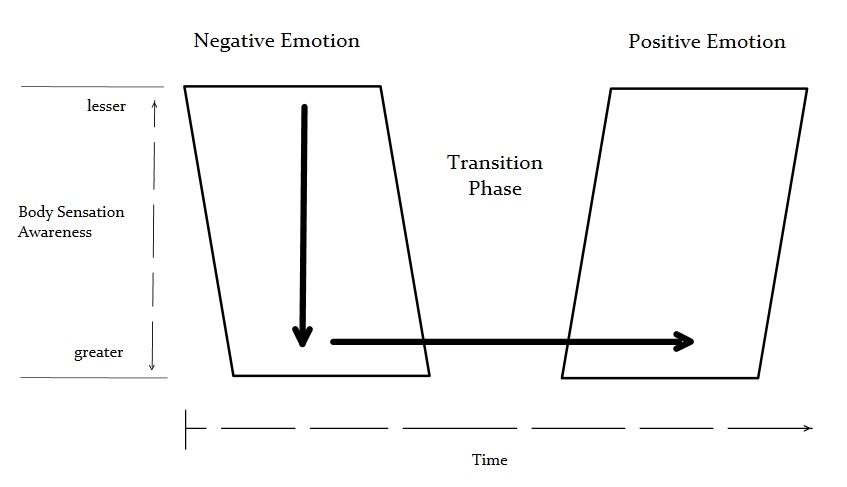Emotional Mastery
To acquire emotional mastery requires first that you become aware of your emotions and the level of activation or intensity they have. You might say well isn’t everyone aware of their emotions, after all they are experiencing them….The answer is no and also a matter of degree.
There is a high degree of variance in how people choose to experience emotions. It is possible to experience emotions almost exclusively in the head and completely disconnected from the body. However, the goal in being able to shape our emotions to our choosing is to feel them viscerally in the body as physical sensations for that is the gateway for releasing the emotions and rewiring our brain.
Trauma of whatever type are emotions that were to intense to deal with and the mind copes with this by dissociating from the body. When people have that blanked out stuck deep in the head look that is a sign of dissociation from the body and emotions felt in the body. The goal is to slowly and progressively reconnect the mind to the body so it can process emotions the way they were intended through physical sensations. Animals do this naturally however humans have an ego that sometimes gets in the way of this process.
Somatic Psychotherapy models have a basic process in common for how to properly work through emotions.
- Use your imagination to bring about a scenario in your mind that left you feeling emotionally uneasy
- Feel the negative emotion viscerally in the body and notice and temperature like sensations, tingling, tightness, contractions, pains, aches, stinging, creepiness, etc.
- Imagine a creative positive outcome to the negative scenario
- Feel how negative emotions transition to positive emotions based on a positive rather than negative outcome
- Take some time sense into and relax into the body and the positive emotions. Mentally notice how those emotions feel sensory wise.
Initially this process will go very slow. If a scenario brings up negative emotions that you feel are too powerful to deal with, try something easier for practice. With time the process becomes easier and can be applied to every single one of your emotions. This is how you gain emotional mastery. It is by working with your emotions rather than against them in a controlling manner. Emotions are fluid like water. The more intense an emotion the slower it needs to be worked through.
Mal-adapted ways of dealing with emotions
Most people deal with uncomfortable, creepy, disgusting, fearful, anxious and other negative emotions by actively trying to negate them. They usually try to do this by repressing them, usually by thinking about something else or becoming preoccupied with a non-correlated task. Most people run away from their negative emotions or try to work around them. These are extremely dysfunctional methods and while they work on the surface the act of repressing emotions drives them deeper causing them to fester often outside of conscious awareness. Then when circumstances bring about triggers, they resurface with a vengeance The more successful a person is at repressing an emotion the greater likelihood also for serious health issues down the road.
Fake it till you make it, is a common way people use the above process. Again this works, however it causes further disconnection of the mind from the body and ultimately does not resolve the root anxiety or fear. The more someone does this the more difficult it becomes for them to work through emotions and this applies to any emotion for the default method/go-to response will then be to repress. Most people are masters of repression, and this is why very few people are present in their bodies often lost in thought and disconnected socially.
The other most common method people use to deal with negative emotions is by ruminating about them. Ruminating is the tendency for people to repetitively focus on the causes and consequences of their problems without engaging in active problem solving. People often try to figure out ways they can logically fix an emotional problem when, when the problem is often best addressed by emotionally working through it.
——————–
The following relevant excerpts are taken from The Seth Material.
“Now if you read a book in your situation that instructs you to contemplate goodness, to turn your thoughts immediately to love and light when you feel irritated, you are in for trouble. Such practices will only serve to make you more frightened of your natural emotions. You will not understand why you have them any better than you did before. You may only hide them more cleverly, and perhaps become ill if, given the situation, you are not already.”
“When you feel the rise of unpleasant emotions, take a moment and make an effort to identify their source. The answers are far more available than you may have previously believed. Accept such feelings as your own in the moment. Do not shove them underneath, ignore them or try to substitute what you think of as good thoughts.”
“First be aware of the reality of your feelings. As you become more aware of your beliefs over a period of time, you will see how they bring forth certain feelings automatically. A man who is sure of himself is not angry at every slight done him, nor does he carry grudges. A man who fears for his own worth, however, is furious under such conditions. The free flow of your emotions will always lead you back to your conscious beliefs if you do not impede them.”
“The fear of your own emotions can do far more damage than their expression, because the apprehension builds up a charge that intensities the energy behind them.”
 “accept the validity of such feelings as feelings — not to inhibit them, but to follow their flow with the under-standing that they are feelings about reality. As themselves they are real. They express emotional reactions to beliefs. The next time Andrea feels inadequate, for example, she is to actively experience that feeling, realizing that even though she feels inferior this does not mean that she is inferior. She is to say, “I feel inferior,” and at the same time to understand that the feeling is not a statement of fact but of emotion. A different kind of validity is involved. Experiencing your emotions as such is not the same as accepting them as statements of fact about your own existence.”
“accept the validity of such feelings as feelings — not to inhibit them, but to follow their flow with the under-standing that they are feelings about reality. As themselves they are real. They express emotional reactions to beliefs. The next time Andrea feels inadequate, for example, she is to actively experience that feeling, realizing that even though she feels inferior this does not mean that she is inferior. She is to say, “I feel inferior,” and at the same time to understand that the feeling is not a statement of fact but of emotion. A different kind of validity is involved. Experiencing your emotions as such is not the same as accepting them as statements of fact about your own existence.”
“All of these ideas obtain their charge from a basic belief in the powerlessness of the conscious self to form and regulate its experience.”
“Yet on some self-analysis, almost all will find areas in which emotions are expressed only to a certain point. They are not followed through.”
“By going along with feelings you unify your emotional, mental and bodily state. When you try to fight or deny them, you divorce yourself from the reality of your being. Dealing with thoughts and feelings as just directed at least roots you firmly in the integrity of your present experience, and allows its innate motion and natural creativity to thrust toward a therapeutic solution.”
“Fear, faced and felt with its bodily sensations and the thoughts that go along with it, will automatically bring about its own state of resolution.”
“If you habitually deny the expression of any emotions, to that degree you become alienated not only from your body but from your conscious ideas. You will bury certain thoughts and put up biological armor to prevent you from physically feeling their effects upon your body.“
“The body and mind together do present a united, self regulating, healing, self-clearing system.” (The Nature of Personal Reality)
—————-
 “It is, as a rule, lack of knowledge on the part of the ego as to the nature of reality, and its part in it, and the resulting fear, that often prevents a personality from accepting spontaneous expression of emotions in general. The capacity to feel is important. When one fears to experience seemingly unpleasant emotions, the personality also tends to set up an emotional pattern of rejection that seriously cuts down, also, not only on the expression but the very perception of joy.
“It is, as a rule, lack of knowledge on the part of the ego as to the nature of reality, and its part in it, and the resulting fear, that often prevents a personality from accepting spontaneous expression of emotions in general. The capacity to feel is important. When one fears to experience seemingly unpleasant emotions, the personality also tends to set up an emotional pattern of rejection that seriously cuts down, also, not only on the expression but the very perception of joy.
This does not mean that the personality must be completely swept away by an emotion, though this is what such an ego fears. Emotion replenishes even the ego. Emotions demand resiliency, and resiliency is both the result of spontaneity, inner assurance, and discipline. All this is action, for the personality itself is composed of action, and is constantly changing. This is action, therefore, delighting in the expression and form of itself…
….The desire to set yourself apart from emotion, and coolly appraise it, is merely an indication of the ego’s characteristic nature. It tries to separate itself from action, to view it objectively, and to see itself as something apart from action.
Since it is itself action, such an attempt is basically doomed to failure. Yet the very attempt causes the formation of the ego. Once this apparent separate ego is formed, and once a fair amount of stability is maintained, and a new identity arrived at, the initial desire and energy will maintain the ego in its position during its existence in any field. Since this existence of separate identity is assured, attempts should then be made so that the ego can better participate in its realization of action, and the emotional life is very important in this respect.
In any fairly normal personality the intellect will indeed stand guard. There is no need to fear identity’s complete immersion into emotional sensation. Such emotional experience actually strengthens not only the ego but it opens communications between the ego and the subconscious, and allows for a much greater flow of energy from the primary source of action.
This energy, incidentally, can be most effectively used for creative work.” (ES Book 4:152)
—————-
“Energy cannot be retained. It must be discharged. The very attempt to deny an action automatically changes the nature of the action, and also changes the nature of the individual who attempts to deny it. All energy seeks to materialize itself, which is another way of saying that action must act.
In the psychological realm it goes without saying that a repressed emotion is never really repressed, since action cannot be retained. It must change. The cause of such difficulties lies not in the repression of an emotion, for this is impossible. The emotion in one way or another, will out, but the difficulty lies in the attempt to repress the emotion. This attempt is itself an action.
There is a term used occasionally to the effect that an emotional block is like a wall. The analogy is an excellent one. I have told you earlier that there are other kinds of structures beside physical structures. Emotions and thoughts have their own structures, that may be manipulated in the same manner that physical objects are manipulated, generally speaking.
An action has reality, as you know, within every possible field of activity. An emotion has an electrical and chemical structure. This is extremely important. It is not a structure that takes up space as you know it, obviously, but it is a structure nevertheless, and could be compared to the appearance of dream locations.
 Emotions are a quite natural portion of action, and left to themselves are fluid. They have electrical validity, and shape. When an attempt is made to reject an emotion, this does not affect the emotion half as much as it affects the individual involved. The act of rejection in itself is detrimental and doomed to failure.
Emotions are a quite natural portion of action, and left to themselves are fluid. They have electrical validity, and shape. When an attempt is made to reject an emotion, this does not affect the emotion half as much as it affects the individual involved. The act of rejection in itself is detrimental and doomed to failure.
You may perhaps come closer to understanding how these psychological structures are manipulated if you consider the same sort of structures as they exist as dream objects in sleep.
If you toss a ball in a dream, neither the self that tosses the ball, nor the ball, exist in any space structure as you know it. In somewhat the same manner are emotion structures handled. A refusal or a denial, an attempt not to handle a particular emotional structure involves action. The refusal itself is an action.
What you have here is an attempt to objectify, or stand apart from action in such a refusal. This is not the fault of the subconscious, but a fault of the ego, which refuses to assimilate or accept a given action. As you know, it is the ego who exists as a result of such objectivity. All the qualities that make up the ego are objectified to that degree, but they are collected about the ego with the ego as center. When the ego however refuses to accept an emotion as a part of itself, it tries one of two actions.
Either it attempts to return the emotion to a subjective state, or it attempts to objectify it further away from itself. In either case the ego is at fault for not assimilating or accepting the emotion. It is easy to see then that the ego is itself a series of actions, that it is a collection of more or less similar actions, selected from a larger mainstream of other actions.
You will recall that the ego, while disliking change, is nevertheless dependent for its identity upon change. The ego to a large degree, therefore, chooses during its development those characteristic actions which will form its nature. Because the ego necessarily changes however, actions or emotions which at one time it chose as acceptable, at a later date so to speak it may attempt to deny.
The habitual pattern or characteristic nature of the ego may then be led to refuse to accept an emotion, at the same time that a pattern has already been set to receive the particular type of emotion. Here the ego fights against itself. Such an emotion may of course be given release through dreams, but this is of limited value to the ego involved, since the ego does not accept the reality of dream existence.
The strength of the ego actually depends on the flexibility with which it can accept and assimilate ever more complex actions, and give them a unity of its own. An action or emotion not accepted by the ego, but nevertheless a part of it, will always drain energy from the main core of the ego, despite the egos denial, and energy that cannot therefore be used by the ego for the purposes of its own purposeful action.
The rejected emotion, in other words, will express itself in any case, but it will do so then as a rebel, outside of the organizational directives of the ego itself. Hence for example, actions that appear senseless to the ego are often the results of such unassimilated or denied emotions. At one time or another such emotions were acceptable to the ego. There was an attraction, or the emotion would not have been permitted to enter into a realm close to ego control.” (ES Book 4: session 156)
Further reading:
Further reading:



